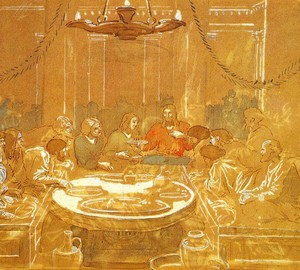The Last Supper, Alexander Ivanov – description of the painting

Description of the picture:
The Lost Supper – Alexander Andreevich Ivanov. Watercolor on paper. 26.6 x 39.7 cm
Studying the work of the Russian artist, creator of the famous painting “The Appearance of Christ to the People” by Alexander Andreevich Ivanov, you come to the conclusion that his works need not be looked at, but to be sluggishly, without fuss, seep into the very essence of the canvas, try to unravel the real idea of this deepest artist.
A huge part of his own life, from one thousand eight hundred and thirty-one to one thousand eight hundred and fifty-eight years, Ivanov spent in Italy, where he not only worked, but also devoted a lot of time to spiritual development, reflection, debate with friends and like-minded people about the spiritual transformation of man Christian era.
In the same period, his well-known “Biblical subjects” emerged, representing a cycle of two hundred watercolor sheets – studies, sketches, sketches, and also an unlimited number of sketches.
Art connoisseurs believe that some sketches, including the popular “Last Supper”, are masterpieces, an independent artistic value in terms of meaning and quality of execution.
Paper, watercolor, whitewash, Italian pencil, and here we have Ivan the Last Supper.
The plot of the picture has been known for thousands of years: in a secret place gathered disciples, a round table, a large hall with the highest columns, the apostles listening to Christ, Judas, sold for 30 pieces of silver. “Verily I say unto you, Jesus, one of you will soon throw me.”
Ivanov’s sketch is completely different from the work of other creators of the plot of the Last Supper. Jesus Christ with him is always the center, the top, the main event. Any figure is expressive, the contour line of the picture is movable and accurate. At the same time, the whole group is united by depth and light.
Thanks to the talent of the painter in this small watercolor, executed in a style completely unusual for the church plot, a memory is created of the presence of the creator, of a certain “historicity” of the moment when all the images of the characters look not canonical, but alive, human."